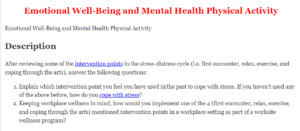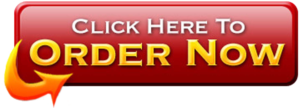Emotional Well-Being and Mental Health Physical Activity
Emotional Well-Being and Mental Health Physical Activity
Emotional Well-Being and Mental Health Physical Activity
Description
After reviewing some of the intervention points in the stress-distress cycle (i.e. first encounter, relax, exercise, and coping through the arts), answer the following questions:
- Explain which intervention point you feel you have used in the past to cope with stress. If you haven’t used any of the above before, how do you cope with stress?
- Keeping workplace wellness in mind, how would you implement one of the 4 (first encounter, relax, exercise, and coping through the arts) mentioned intervention points in a workplace setting as part of a worksite wellness program?
Chapter 7 Stress, Emotional Well-Being, and Mental Health Physical Activity • Physical activity is defined as any bodily movement produced by skeletal muscles that requires energy expenditure Any movement during the day is physical activity, including walking, climbing stairs, and housework. • Exercise is a subset of physical activity that is planned, structured, and repetitive and has as a final or an intermediate objective to improve or maintain physical fitness level. Aerobic, muscle-strengthening, bone-strengthening, and stretching activities Mental and Emotional Health Sound mental and emotional health is linked to: • Better health • Educational achievement • Productivity • Higher earnings • Improved relationships • Greater resilience • Better overall quality of life Stress Our mental and emotional well-being primarily depends on our ability to deal with stress • More than 70% of Americans experience regular physical and psychological stress symptoms; over half rate their stress levels as moderate to high and a third of those report living with extreme stress. • The American Academy of Family Physicians estimates that twothirds of all office visits to family physicians are because of stress-related symptoms. Stress • At work, eight in ten employees report job-related stress and nearly half say they need help managing stress. The cost of job stress is estimated at more than $300 billion annually in the United States. • Chronic stress is associated with a greater risk for many illnesses such as depression, cardiovascular disease, diabetes, autoimmune diseases, upper respiratory infections, and poorer wound healing. The Stress Response • Also known as “fight-or-flight” • Begins with conscious or unconscious interpretation of event • Threat activates physiologic reaction within nervous and endocrine systems, initializing protective bodily functions • Once stressor is gone, body returns to homeostasis The Stress Response • Consider Cave Man example • Stressors can be nonphysical: pressure of a deadline, fear for a loved one’s safety • Tend and Befriend alternative: More often found in women; less confrontational Stress Physiological Response • Decreased digestive activity • Increased metabolic rate • Increased sweating • Decreased salivation • Increased muscular tension • Increased cardiac function • Altered immune response • Decreased clotting time • Increased glucose use • Increased fat mobilization • Increased muscle breakdown Autonomic Nervous System (ANS) • part of the peripheral nervous system (brain, spinal cord, and nerves) that regulates involuntary body functions. • Autonomic functions are automatic or reflexive, regulating many of our vital body functions, such as heart rate and respiration. This system has two parts: (1) the sympathetic nervous system, recognized as the stress system because it excites and speeds you up (2) the parasympathetic system, known for stimulating the relaxation response and helping the body return to a relaxed, normal state. • Inciting the sympathetic system releases chemicals and hormones that initiate the stress response, increasing capabilities of essential organs of the body and constraining organs that are not essential. Endocrine System • made up of glands that secrete hormones into the blood stream: Pituitary – pea-sized gland located at the base of the skull, is often called the master gland because it controls all other glands. Pituitary hormones trigger hormone release in other organs. Thyroid – located in the front of the neck below the larynx, regulates metabolism, and in reaction to stress its hormones increase the rate with which the body can use energy. Adrenal – located on the top of each kidney have two distinct parts: an outer part called the cortex, which produces steroid hormones such as cortisol, aldosterone, and testosterone, and an inner part called the medulla, which produces adrenaline and noradrenaline. The adrenal cortex produces a glucocorticoid called cortisol, which increases blood sugar and assists in metabolizing fat, protein, and carbohydrates. Immune System • primary role to protect the human body against infections such as bacteria, viruses, and cancerous cells. • Stress is known to suppress immune function and increase susceptibility to infections and cancer; however, recent observations by Dhabhar (2009) suggest that stress may suppress immune function under some conditions and enhance it under others. • Chronic or long-term stress seems to suppress immunity by decreasing immune cell numbers and function and increasing regulatory T cells • During acute stress, immune function can be enhanced. Eustress vs Stress • Not all stress is bad; stress is necessary to achieve success and protect from physical and psychological demands Stages of Stress Response to stress goes through three stages known as General Adaptation Syndrome: • Alarm: prepare for action • Resistance: arousal reduced to a manageable level • Exhaustion: protective resources depleted *Chronic illness is most likely to develop at this stage Coping with Stress Stress is largely a result of a person’s interpretation to a situation. Processing occurs in the prefrontal cortex before reaching the mid-brain where stress reaction is initiated There are at least four intervention points in the stress-distress cycle where individuals have an opportunity to effectively cope with stress Opportunity 1: First encounter • Initial interpretation of a stressor sets the physiologic stress response in motion. If we view a threat as being more or less than it really is, we risk being ineffective at dealing with it, and we will be harmed either by the stressor itself or by the stress hormones being produced. • Coping mechanisms include mindfulness, spirituality, finding purpose and meaning, visualization and self-talk, gratitude, and managing one’s environment Opportunity 2: Relax • The act of breathing is a simple yet powerful way to bring about a parasympathetic relaxation response that stops the flow of stress hormones, calms us, and returns our body to equilibrium. • Coping mechanisms to induce relaxation include deep breathing, Imagery, progressive muscle relaxation, meditation, touch and massage, and anchoring Opportunity 3: Exercise • By using major muscle groups during exercise, our body metabolizes excess blood sugar, fats, and stress hormones (adrenalin and cortisol), and with the hormones gone, our body can return to homeostasis. • In addition to immediate responses, it is believed that regular exercise over time reduces the amount of adrenalin and cortisol released during other stressful times and may weaken neural mechanisms involved in the stress response resulting in lower sympathetic nervous system activity in response to perceived stress • Exercise has long been known to improve mood and reduce anxiety. • Increases daily energy levels, boosts self-confidence, and creates a sense of accomplishment. • Brain chemicals such as endorphins and serotonin are released during exercise and produce a feeling of euphoria Opportunity 4: Coping through the Arts • Expressive therapies are considered to help manage stress and build resilience over time. • Coping mechanisms include: music, art, writing, drama, photography, dance, drumming, and play Stress in the Work Place 14,000,000,000 Working days lost to stress, depression, and anxiety in the US each year $300 BILLION Lost Stress at the Work Site • Stress in the work place is based on the psychological demands vs the perceived control one has in his or her position (demand – control relationship) • Control is found to be the greatest predictor of stress in this environment • Sense of ownership, meaning, and purpose can make a huge difference regardless of how stressful the demands of a job are Work Site Stress Management Objectives: 1. Create a healthier workplace 2. Build the capacity of employees to cope with stress through targeted stress management programs Sources of stress include the physical and social environment, organizational policies, and the workers themselves. Work Site Stressors • Noise, lighting, ergonomics (equipment design factors), temperature, and repetitive tasks • Shift work • Travel requirements • Racism and racial and ethnic prejudice • Sexism and sexual harassment • Gender and racial discrimination • Work-family balance • Support for diversity in the workplace • Boredom/meaningless work • Lack of communication Mental Health • Suicide is the 10th leading cause of death in the US • Antidepressants is the fastest growing class of prescription drugs as of 2010 • US lacks a strong mental health program Mental Health – Good News The Patient Protection and Affordable Care Act (ACA) includes mental health parity laws designed to stop insurers from arbitrarily limiting care for mental health as well as: (1) include mental health disorders in a set of health care service categories that must be covered by certain insurance plans as “essential services,” including those offered through the exchanges and Medicaid (2) allow people who are underinsured due to preexisting mental health conditions access to a new preexisting condition insurance plan (3) prohibit insurers from denying coverage of mental illness as a preexisting condition or to use mental health conditions to raise premiums (4) require private plans to continue coverage for dependents until they turn twenty-six years old Addressing Mental Health • Prevention is crucial! • Community prevention programs may include grief support groups, suicide prevention training, depression education, resilience training, etc. • Mental health treatment includes psychotherapy, cognitive behavioral therapy, assertive community treatment (multidisciplinary 24/7 staffing of psychiatric team within the individual’s home or community), supportive housing, self-help groups, support groups, and peer support services Mental Health and Disparities • Homelessness and poverty are predictive of mental health, substance abuse, and physical health issues which can further add to experiences of stress • Underserved populations typically experience a greater quantity of stressors such as lower pay, higher incidence of illness, lack of transportation, etc. Do children feel stress? • Stress is often considered an adult-only issue, but children experience their own day-to-day stressors • Children lack the complex social and emotional understanding required to identify and cope with stress • Children may react to stress by changing their behavior (i.e. fighting, teasing, whiny, or nervous) • Physical complaints may also occur such as upset stomach, headache, or vomiting • Long-term affects include poor self-image, self-confidence, performance, and social skills Child Stressors • Time demands • Parent or school expectations • Social pressure • Separation from parents • Punishment • Sibling rivalry • Divorce or family discord • Moving • Death in the family • Etc.
Use the following coupon code :
NursesHomework


